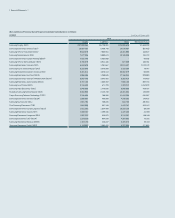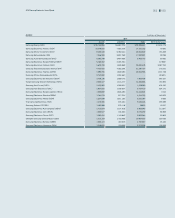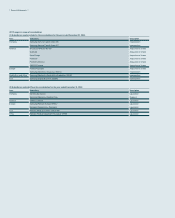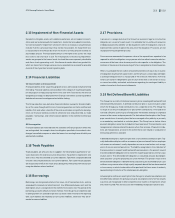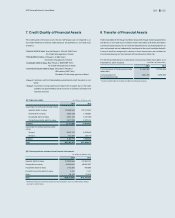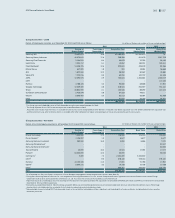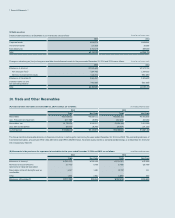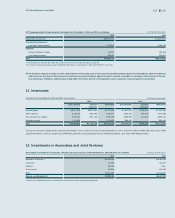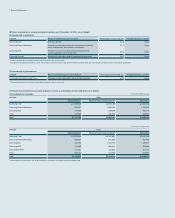Samsung 2014 Annual Report Download - page 62
Download and view the complete annual report
Please find page 62 of the 2014 Samsung annual report below. You can navigate through the pages in the report by either clicking on the pages listed below, or by using the keyword search tool below to find specific information within the annual report.
Financial Statements
2.19 Financial Guarantee Contract
Financial guarantee contracts are contracts that require the issuer to make speci-
fied payments to reimburse the holder for a loss it incurs because a specified debt-
or fails to make payments when due. Financial guarantees are initially recognized
in the financial statements at fair value on the date the guarantee was given. If the
amount measured in subsequent periods exceeds the unamortized balance of the
amount initially recognized, the excess is classified as other financial liability.
2.20 Current and Deferred Tax
The tax expense for the period comprises current and deferred tax. Tax is recog-
nized on the profit for the period in the statement of income, except to the extent
that it relates to items recognized in other comprehensive income or directly in
equity, in which case the tax is also recognized in other comprehensive income or
directly in equity, respectively. The tax expense is calculated on the basis of the tax
laws enacted or substantively enacted at the end of the reporting period.
Deferred tax is recognized for temporary differences arising between the tax
bases of assets and liabilities and their carrying amounts as expected tax conse-
quences at the recovery or settlement of the carrying amounts of the assets and
liabilities. However, deferred tax assets and liabilities are not recognized if they
arise from initial recognition of an asset or liability in a transaction other than a
business combination that at the time of the transaction affects neither accounting
nor taxable profit or loss. Deferred tax assets are recognized only to the extent that
it is probable that future taxable profit will be available against which the temporary
differences can be utilized.
A deferred tax liability is recognized for taxable temporary differences associat-
ed with investments in subsidiaries, associates, and interests in joint ventures,
except to the extent that the Group is able to control the timing of the reversal of
the temporary differences and it is probable that the temporary difference will not
reverse in the foreseeable future. In addition, a deferred tax asset is recognized
for deductible temporary differences arising from such investments to the extent
that it is probable the temporary difference will reverse in the foreseeable future
and taxable profit will be available against which the temporary difference can be
utilized.
Deferred tax assets and liabilities are offset when there is a legally enforceable
right to offset current tax assets against current tax liabilities and when the de-
ferred income taxes assets and liabilities relate to income taxes levied by the
same taxation authority on either the same taxable entity or different taxable enti-
ties where there is an intention to settle the balances on a net basis.
2.21 Derivative Instruments
All derivative instruments are accounted for at their fair value according to the
rights and obligations associated with the derivative contracts. The resulting
changes are recognized in profit or loss in the year in which they are incurred. Cer-
tain derivatives that qualify as cash flow hedges and hedges on net investments in
foreign operations are recognized under equity.
2.22 Dividend
Dividend distribution to the Group’s shareholders is recognized as a liability when
the dividends are approved.
2.23 Share Capital
Common shares and preferred shares with no repayment obligations are clas-
sified as equity. When the Group purchases its common shares, the acquisition
costs, including direct transaction costs, are deducted from equity until the re-
demption or reissuance as treasury shares. Consideration received on the subse-
quent sale or issuance of treasury shares is credited to equity.
2.24 Revenue Recognition
Revenue mainly comprises the fair value of the consideration received or receiv-
able for the sale of goods in the ordinary course of the Group’s activities. Revenue
is shown net of value-added tax, returns, sales incentives and discounts and after
eliminating intercompany transactions.
The Group recognizes revenue when the amount of revenue can be reliably
measured; when it is probable that future economic benefits will flow to the entity;
and when specific criteria have been met for each of the Group’s activities, as de-
scribed below. The Group measures revenue by reliably estimating the contingen-
cies associated with revenue based on historical results, taking into consideration
the type of customer, the type of transaction and the specifics of each arrange-
ment.
Where multiple-element arrangements exist, the fair values of each element are
determined based on the current market price of each of the elements when sold
separately. When the fair values of each element are indeterminable, the fair val-
ues of deliverables which have already been provided are calculated in such way
that the fair values of elements which are yet to be provided are subtracted from
total contract value of the arrangement.




